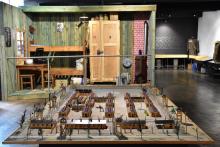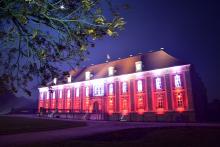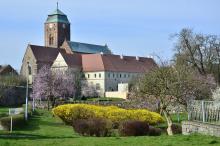Żagań
English
ŻAGAŃ FOR THE WEEKEND
Żagań is located in the western part of Poland, close to the German border and at the southern edge of the Lubusz Voivodeship. Rich history of the town, interesting architecture and picturesque location on the bank of the Bóbr River among greenery of the Lubusz forests make Żagań an ideal place to spend an active weekend.
Undoubtedly, the most important point on the city map is the Książęcy Palace, which in the past housed many distinguished families – from the Lobkovics through the Biron family to the Talleyrand family. Currently, the monumental palace and the surrounding landscape park with numerous fountains is open to everyone – it is here where you should start your wandering around the most interesting corners of Żagań.
Mentioning the most important tourist attractions we cannot omit two historic complexes inseparably connected with the city history. The first of them is the post-Augustine monastery complex with the impressive Augustinian library. This building has the status of a Monument of History. The second one is the Hospital Complex of St. Dorothy located at Żelazna Street, which consists of the main building of the former hospital with the chapel of St. Dorothy, the Church of the Holy Cross and the Loretto chapel. It is a peculiar showcase of the heritage left by Duchess Dorota de Talleyrand-Périgord of Żagań. Lovers of beautiful views are encouraged to visit the tower of the former Lutheran church. It is currently used as an observation tower and you can admire the city panorama from there.
Leaving the town center you can see the remains of the prisoner-of-war camps of the First and Second World War. On the outskirts of Żagań there were Stalag VIIIC and Stalag Luft 3, famous, among others, for the Great Escape of the Allied airmen, which became the basis for the film "The Great Escape" starring Steve McQueen. Nowadays, the vast grounds of the camp host the Museum of Prisoner-of-War Camps with numerous exhibitions, including a replica of a camp barrack and guard towers.
Żagań is undoubtedly a town which follows the trend of film tourism (so-called set jetting) – it was here that the famous scenes from the first series of "Czterech pancernych i psa" by Konrad Nałęcki or fight scenes in "Potem nastąpi cisza" by Janusz Morgenstern were shot. The events taking place in Żagań were also an inspiration for the film "The Wooden Horse.”
We encourage to visit the town full of surprises and tourist attractions, where some extraordinary people such as an outstanding astronomer, Jan Kepler, progressive Duchess Dorota de Talleyrand-Périgord or famous Gypsy poetess, Papusza (Bronislawa Wajs) spent part of their lives.
Żagań Town Hall
Plac Słowiański 17
68-100 Żagań
https://urzadmiasta.zagan.pl/
The public task is co-financed from the funds received from the Marshal's Office of the Lubuskie Voivodeship





